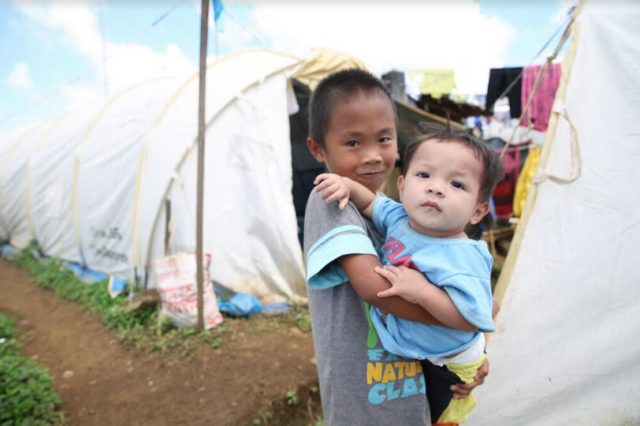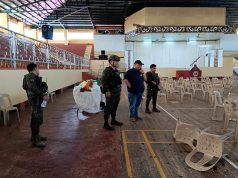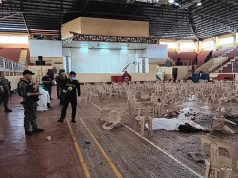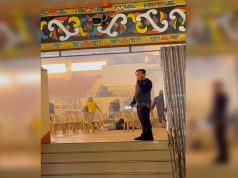ISLAMIC CITY OF MARAWI – The chorus of tiny voices of a dozen children donned in colorful shirts rang inside the provincial capitol one afternoon.
They were singing Awit sa Marawi, a local composition by a Grade 5 student about the futility of wars and hopes for rebuilding. The singing became more spirited as a senator and foreign guests arrived. When the choir finished, the guests joined them and posed for photographs.

Amid the supposedly cheery atmosphere, Lydia (not her real name) sat in one corner and began to shed tears, taking the lyrics to heart.
“She joined the visitors in the tour to ‘ground zero’ and saw her home torn from the fighting, that’s why she’s crying. Her family is left with nothing,” a social worker said.

Thousands of Marawi residents have been living in the city’s outskirts since the fighting between government forces and the ISIS-inspired Maute group began in May this year. President Rodrigo Dueterte declared martial law in Mindanao on May 23, and got the nod of Congress last July 22 to extend it up to December 31, 2017.
The Constitution requires the extension to be approved by Congress.
Even after the President declared in October that the city had already been liberated with the killing of Maute leaders, majority of the residents were still not allowed to return, especially in Marawi’s ground zero, which covers villages reduced to rubble due to incessant shelling and bombing.

The families of Laida Lanto, Johayver Lanto and Nuraima Ali Otto from Barangay Lilod and Barangay Papandayan live in a hall that was converted into an evacuation center within the provincial capitol’s compound.
“We have been here since the fighting started. We want to be able to move freely and return home. We need money, too, because we lost everything. Our house now is just a skeleton,” Laida Lanto said.
They said they also do not want to live on relief items, because they can work, and fear the day when assistance would stop coming.

Around the city, transient shelters or tent cities, made up of white tents, were set-up for evacuees.
Military checkpoints were also stationed in various areas within Marawi. It has become normal for armed soldiers to take a quick peek inside vehicles or ask for IDs of people passing by.
To be able to entry ground zero, the site of the fiercest battle, one has to pass through Camp Ranao, where the 103rd Brigade military camp is situated. After securing permits, which will be processed for two days, the military sometimes allow visitors to see the devastation.

On Thursday, December 7, it was Senator Richard Gordon who visited the area, together with representatives of the United Nations High Commissioner for Refugees, TV5’s Alagang Kapatid, and representatives Alfredo Benitez of Negros Occidental and Arnolfo Teves of Negros Oriental.
Benitez, chairperson of the House Committee on Housing, is looking forward to Marawi’s rehabilitation, but warned local officials to proceed with much caution.
The experience in the housing projects for the victims of Super Typhoon Yolanda should not happen in Marawi, he said. The housing committee following a series of hearings found irregularities in the implementation of the project, such as the use of substandard materials.
“Many of those who suffered from Yolanda’s wrath were victimized twice over as they were forced ti accept substandard houses,” he said.
“Marawi has to be insulated from such despicable acts of corruption and abuse,” he added.

Benitez and Teves on Thursday, December 7 visited one of the temporary relocation sites in the 11-hectare Sagonsongan Transitory Shelter. The area will initially provide 1,100 housing units to Marawi’s internally displaced persons.
Each unit under construction will be 22-square meter in size and will cost P160,000. The budget will be under the National Housing Authority.
“We need to see the rehabilitation plan, the master plan, for us to rebuild Marawi properly,” Benitez said.
“The usual concern of evacuees is the availability of livelihood, or the distance of the shelter to their place of work, we have to be mindful of these,” Teves said.
Alfonso Borlagdan, National Housing Authority officer for Region 9 and the Autonomous Region in Muslim Mindanao, said the turnover of the units is expected on December 23.
Sadick Mohamad, director at the Mindanao State University and consultant of the city for engineering projects, said the post-conflict assessment is ongoing as part of the rebuilding and rehabilitation efforts.
“We are fast tracking the master plan,” Mohamad said, but stressing that the process include consultation with the people.
“In our planning, we consider the needs, tradition, environment of the Marawi people,” he added.
The government had said it would need at least P10 billion to rebuild Marawi.

The five-month fighting has resulted in the displacement of around 375,000 individuals from 96 barangays. Of these, only the residents of 19 barangays not severely damaged by the war have been allowed to return.
Many of the families remain in evacuation centers and tent cities or have temporarily moved to the nearby town or city, such as Iligan, with their relatives.
In ground zero, every corner, every home bears the scars of war. From the fringes, the Marawi people watch with hopeful eyes that they would soon see their city return to life.










